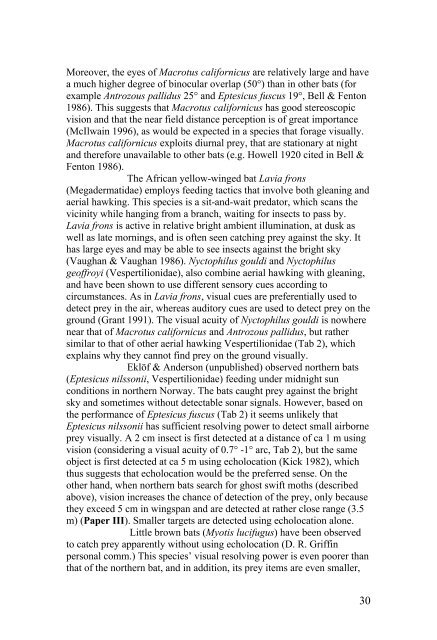Vision in echolocating bats - Fladdermus.net
Vision in echolocating bats - Fladdermus.net
Vision in echolocating bats - Fladdermus.net
Create successful ePaper yourself
Turn your PDF publications into a flip-book with our unique Google optimized e-Paper software.
Moreover, the eyes of Macrotus californicus are relatively large and have<br />
a much higher degree of b<strong>in</strong>ocular overlap (50°) than <strong>in</strong> other <strong>bats</strong> (for<br />
example Antrozous pallidus 25° and Eptesicus fuscus 19°, Bell & Fenton<br />
1986). This suggests that Macrotus californicus has good stereoscopic<br />
vision and that the near field distance perception is of great importance<br />
(McIlwa<strong>in</strong> 1996), as would be expected <strong>in</strong> a species that forage visually.<br />
Macrotus californicus exploits diurnal prey, that are stationary at night<br />
and therefore unavailable to other <strong>bats</strong> (e.g. Howell 1920 cited <strong>in</strong> Bell &<br />
Fenton 1986).<br />
The African yellow-w<strong>in</strong>ged bat Lavia frons<br />
(Megadermatidae) employs feed<strong>in</strong>g tactics that <strong>in</strong>volve both glean<strong>in</strong>g and<br />
aerial hawk<strong>in</strong>g. This species is a sit-and-wait predator, which scans the<br />
vic<strong>in</strong>ity while hang<strong>in</strong>g from a branch, wait<strong>in</strong>g for <strong>in</strong>sects to pass by.<br />
Lavia frons is active <strong>in</strong> relative bright ambient illum<strong>in</strong>ation, at dusk as<br />
well as late morn<strong>in</strong>gs, and is often seen catch<strong>in</strong>g prey aga<strong>in</strong>st the sky. It<br />
has large eyes and may be able to see <strong>in</strong>sects aga<strong>in</strong>st the bright sky<br />
(Vaughan & Vaughan 1986). Nyctophilus gouldi and Nyctophilus<br />
geoffroyi (Vespertilionidae), also comb<strong>in</strong>e aerial hawk<strong>in</strong>g with glean<strong>in</strong>g,<br />
and have been shown to use different sensory cues accord<strong>in</strong>g to<br />
circumstances. As <strong>in</strong> Lavia frons, visual cues are preferentially used to<br />
detect prey <strong>in</strong> the air, whereas auditory cues are used to detect prey on the<br />
ground (Grant 1991). The visual acuity of Nyctophilus gouldi is nowhere<br />
near that of Macrotus californicus and Antrozous pallidus, but rather<br />
similar to that of other aerial hawk<strong>in</strong>g Vespertilionidae (Tab 2), which<br />
expla<strong>in</strong>s why they cannot f<strong>in</strong>d prey on the ground visually.<br />
Eklöf & Anderson (unpublished) observed northern <strong>bats</strong><br />
(Eptesicus nilssonii, Vespertilionidae) feed<strong>in</strong>g under midnight sun<br />
conditions <strong>in</strong> northern Norway. The <strong>bats</strong> caught prey aga<strong>in</strong>st the bright<br />
sky and sometimes without detectable sonar signals. However, based on<br />
the performance of Eptesicus fuscus (Tab 2) it seems unlikely that<br />
Eptesicus nilssonii has sufficient resolv<strong>in</strong>g power to detect small airborne<br />
prey visually. A 2 cm <strong>in</strong>sect is first detected at a distance of ca 1 m us<strong>in</strong>g<br />
vision (consider<strong>in</strong>g a visual acuity of 0.7° -1° arc, Tab 2), but the same<br />
object is first detected at ca 5 m us<strong>in</strong>g echolocation (Kick 1982), which<br />
thus suggests that echolocation would be the preferred sense. On the<br />
other hand, when northern <strong>bats</strong> search for ghost swift moths (described<br />
above), vision <strong>in</strong>creases the chance of detection of the prey, only because<br />
they exceed 5 cm <strong>in</strong> w<strong>in</strong>gspan and are detected at rather close range (3.5<br />
m) (Paper III). Smaller targets are detected us<strong>in</strong>g echolocation alone.<br />
Little brown <strong>bats</strong> (Myotis lucifugus) have been observed<br />
to catch prey apparently without us<strong>in</strong>g echolocation (D. R. Griff<strong>in</strong><br />
personal comm.) This species’ visual resolv<strong>in</strong>g power is even poorer than<br />
that of the northern bat, and <strong>in</strong> addition, its prey items are even smaller,<br />
30


